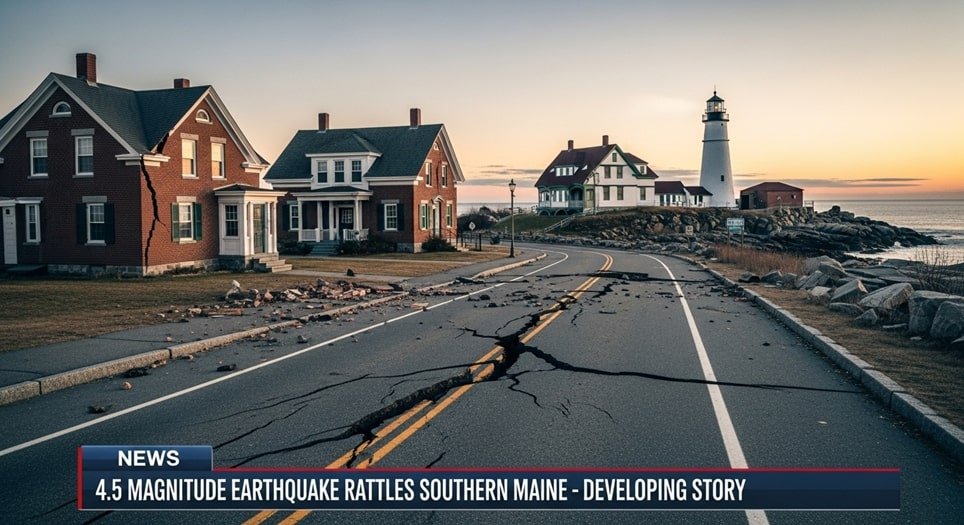Big News: Small Earthquake Shakes Southern Maine — What You Need to Know
Quiet Night, Loud Surprise
Late Sunday evening, residents across southern Maine, especially in York County and parts of New Hampshire, were startled by a sudden, loud boom followed by ground shaking. According to the U.S. Geological Survey, a magnitude 1.9 earthquake was confirmed near the border between Limington and North Waterboro. The quake occurred at 9:18 p.m., about 6.5 miles (roughly 10.5 km) underground. Because of its shallow depth and the geology in that region—rock type, dry ground—people reported feeling more shaking and hearing sounds than one might expect from such a small quake. It even woke some folks up.
What the Experts Say
Seismologists stress that this kind of event is far from unusual in Maine. The USGS notes that the state sees dozens of minor earthquakes each year, many of which go unnoticed. What makes this quake particularly noticeable was its location and timing. When small quakes occur at relatively shallow depths, they often create louder sound effects and more perceptible shaking. Dry soil and rock amplify these effects. The geology beneath southern Maine includes hard rock and variable soil layers, which can transmit vibration and sound more efficiently than softer ground.
Areas Affected & Public Reaction
Even though the quake struck near Limington and North Waterboro, reports of shaking and sound came from as far as Hollis, North Shapleigh, East Baldwin, and parts of New Hampshire. Some residents described the experience as “a strong vibration” or being jarred awake. Many also heard a loud boom, which is common in shallow quakes. No damage has been reported. For most people, the quake was unsettling more than anything else. Social media filled quickly with questions: “Did anyone else feel that?”—a typical response in events like this.
Science Behind What You Felt
Why do some small quakes feel so strong? First, depth matters. The quake’s shallow depth meant less Earth between you and the epicenter to absorb vibration. Second, geology plays a role—some rock types conduct energy better than others. Third, environmental conditions: dry soil often cracks or transmits sound in a way that feels louder, especially at night when ambient noise is lower. Light quakes often include high-frequency waves you see or feel as sound rather than sustained shaking.
What to Do and Keep in Mind Next
If you felt the quake, there’s little you need to do. It’s likely just a small seismic event with no lasting impact. However, experts recommend:
-
Bookmarking the USGS website to monitor if more aftershocks follow. Smaller quakes often come in clusters.
-
Checking building integrity if you live near the epicenter—just to be sure windows, walls, or structural features are okay.
-
Sharing your experience with the USGS via their “Did You Feel It?” feature. That helps improve shaking maps and future readiness.
Putting It in Perspective
Southern Maine isn’t usually known for large earthquakes, but smaller ones are not rare. This quake joins a long list of minor seismic events in Maine over recent years. According to regional seismic data, there was a magnitude 3.8 quake near York Harbor earlier this year that rattled homes across New England. That one too was felt far away, though shallow quakes of this size and lower tend to cause more surprise than damage.
Data Table: The Southern Maine Quake at a Glance
| Metric | Value | Context | Why It Matters |
|---|---|---|---|
| Magnitude | 1.9 | Very small on global scale, similar to daily quakes in Maine | Shows low energy; unlikely to cause damage |
| Depth | ~6.5 miles (~10.5 km) | Shallow quakes < 7-10 miles often felt more clearly | Explains loud boom and perceptible shaking |
| Epicenter | Between Limington & North Waterboro | Rural location with mixed rock and soil geology | Affects who felt it and how the ground responded |
| Time | ~9:18 p.m. local time | Evening timing makes sound & shaking more noticeable | Less background noise amplifies perception |
| Damage Reports | None | No structural or personal injury reported | Confirms low risk despite the perceptibility |
The Takeaway
This magnitude 1.9 quake in southern Maine serves as a reminder that even small seismic events can be startling, especially when shallow, loud, and unexpected. The key is understanding that magnitude isn’t the only factor in how we experience earthquakes. Depth, geology, soil conditions, and ambient surroundings all play a big role. It’s nothing dangerous in most cases, but it’s useful to know what to expect and how to respond calmly.
If you live in quake-prone or lightly seismic zones, it’s smart to have a general awareness of how to respond: secure heavy furniture, know your exit points, and keep building safety in mind. For now, officials see no threat, just a reminder that the ground beneath us is alive—even in places we often feel safe from major quakes.
